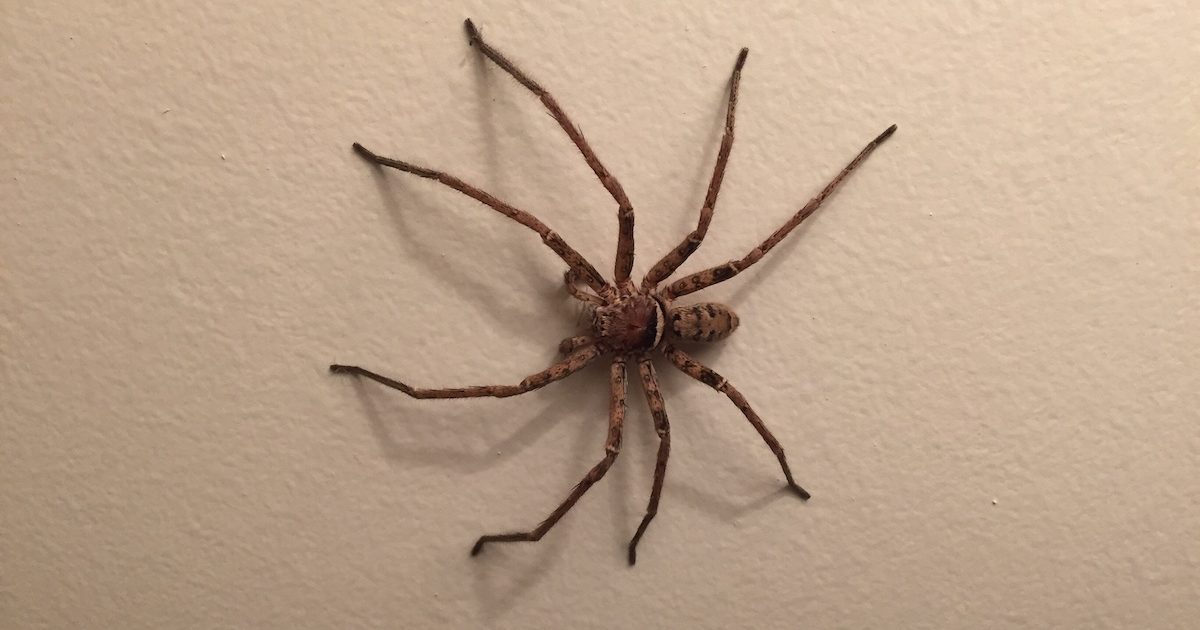
Huntsman spiders are large, fast spiders distributed in warm climates throughout the world.
They live in some warm American states such as Florida, Georgia, California, and Texas, and, according to the Conservation Institute, it is presumed that they were introduced from Asia. It is sometimes said that they traveled from Asia in boxes of bananas, and because of that, they are sometimes called banana spiders.
Learn more about this interesting spider below.
What Do They Look Like and What Makes Them Unique?
Because of their size, huntsman spiders are sometimes incorrectly identified as tarantulas. One way to tell a huntsman from a tarantula is by the position of the creature’s legs.
Huntsman spiders usually have legs that are splayed out to the sides, crablike. In fact, huntsman spiders are also referred to as giant crab spiders. Huntsman spiders’ legs have twisted joints, which allow the appendages to extend forward like a crab’s. Their alignment allows them to move side-to-side, further explaining the crab nickname.
Colors and patterns vary but the spiders’ legs are typically gray or brown and banded. Many huntsman species’ bodies have a flattened appearance.
The average huntsman spider species is about 1 inch (2. 5 centimeters) long with a leg span of up to 5 inches (12. 7 cm). The giant huntsman spider, however, has a leg span of up to 12 inches (30 cm), making it the largest spider by diameter; it is often described as being “the size of a dinner plate.”
They are notable for the way that they catch their prey. Huntsman spiders “don’t build webs to catch prey,” explained entomologist Christy Bills, Invertebrate Collections’ manager at the Natural History Museum of Utah. Rather, they hunt down their prey, a habit that gives them their common name.
The spider typically lives under loose bark on trees, under rocks, in crevices, and under foliage.
A Different Kind of Pet
Some people keep Huntsman Spiders as pets.
Different species have different needs, so it is important to do adequate research before purchasing one as a pet. Most of these creatures are solitary, and rarely interact with one another outside of breeding. They are reclusive during the day, and more active at night. During the day it is not uncommon for them to hide in tree bark, woodpiles, forests, sheds, houses, cars, and more.
If you are so inclined, perhaps they can make good, hands-off, pets. However, their bite is quite painful. In human care, these spiders must be kept in a secure enclosure, as they are very capable of climbing walls and ceilings. They should be provided plenty of hiding places for them to retreat to during the day.
How Do They Multiply?
The many different species have a wide variety of mating behaviors.
Compared to other spider species that eat their mates, huntsman spiders are downright romantic. Their mating ritual can last for several hours and involves lengthy caresses and other demonstrations of interest.
Females rarely attack the males after breeding, unlike some other spider species. After breeding, the female will produce an egg sac wrapped carefully in silk. This egg sac can contain up to 200 eggs. Most species will protect their egg sac until it hatches, viciously attacking any who get too close.
“Some huntsmans are dedicated mothers,” said Bills. They “look after their egg sacs, guarding them fiercely.” Some females carry the sac with them under their bodies, which severely restricts their movements.
In both cases, females may become aggressive when guarding their egg sacs. The mother may tear the egg sac open to help her spiderlings emerge. She’ll then stay with the babies for several weeks. Baby huntsmen are pale in color and darken with each molt.
Having An Issue With The Mighty Huntsman Spider?
These are common spiders in Georgia. If you’re noticing them around your property don’t get too close. Their bite can be quite painful.
Let the professionals come in and get rid of them for you. Here at Drive Bye Exterminators, we specialize in spider control.
We will be happy to come to take a look at your property, get rid of any active spiders, and seal your home up tight to make sure they can’t get in again. This way you can have peace of mind that only those you choose are taking up residence in your house.
Contact us here to schedule an inspection, and we will be happy to give you a quote for removing the spiders from your property.






